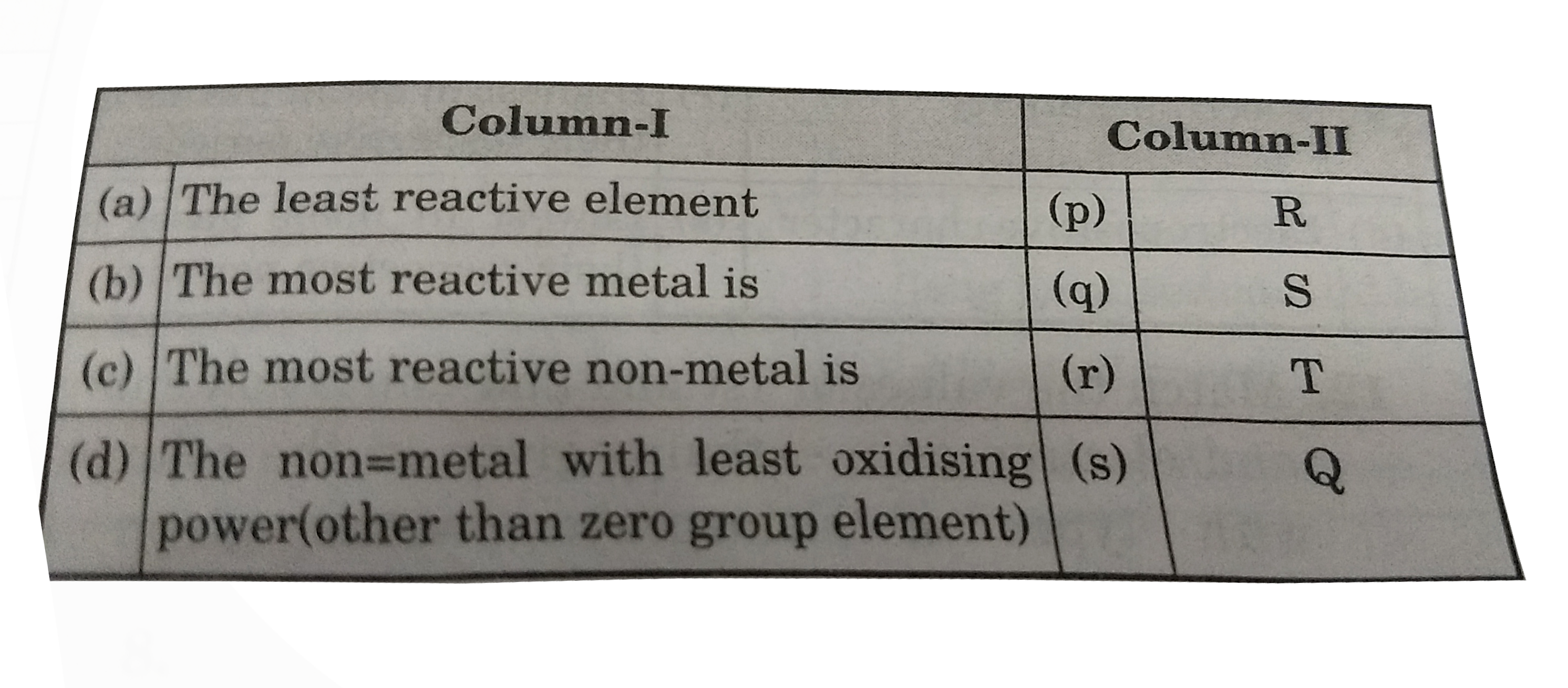Calculate lattice energy for the change,
Li+(g)+Cl−(g)→LiCl(g)
Given that
ΔHsublimation of Li=160.67kJmol−1,ΔHDissociation of Cl2=244.34kJmol−1,ΔHionisation of Li(g)=520.07kJmol−1,ΔHE.A of Cl(g)=−365.26kJmol−1,ΔHf of LiCl(s)=−401.66kJmol−1,Solution in Tamil

ΔHf=ΔH1+ΔH2+ΔH3+2ΔH4+u
−795=121+2422+242.8+(2×355)+u
−795=2785.8−710+u
−795=2075.8+u
u=−795−2075.8=−2870.8kJ.mol−1
Topper's Solved these Questions
- THERMODYNAMICS Book:SURA PUBLICATIONChapter:THERMODYNAMICS Exercise:ADDITIONAL QUESTIONS
Explore 87 Videos
- THERMODYNAMICS Book:SURA PUBLICATIONChapter:THERMODYNAMICS Exercise:ADDITIONAL SHORT ANSWERS
Explore 46 Videos
- THERMODYNAMICS Book:SURA PUBLICATIONChapter:THERMODYNAMICS Exercise:NUMERICAL PROBLEMS
Explore 19 Videos
- SURAS. MODEL QUESTION PAPER - 2 Book:SURA PUBLICATIONChapter:SURAS. MODEL QUESTION PAPER - 2 Exercise:Part - D (Answer all five questions:)
Explore 15 Videos
Similar Questions
Which of the following is an extensive property?
View SolutionGiven the relation between enthalpy (H) and internal energy (U).
View SolutionThe entropy change in the conversion of water to ice at 272 k for the system is −22.88JK−1mol−1 and that of surrounding is +24.85jk−1mol−1 State whether the process is spontaneous or not ?
View SolutionWrite down the postulates of Bohr atom model.
View SolutionCalculate the lattice energy of the reaction Li^(o+)(g) +CI^(Theta) (g) rarr LiCI(s) from the following data: Delta_("sub")H^(Theta)(Li) = 160.67 kJ mol^(-1), (1)/(2)D(CI_(2)) = 122.17 kJ mol^(-1) IP(Li) = 520.07 kJ mol^(-1),E_(A)(CI) = - 365.26 kJ mol^(-1) and Delta_(f)H^(Theta)(LiCI) =- 401.66 kJ mol^(-1)
View SolutionGiven C_(2)H_(2)(g)+H_(2)(g)rarrC_(2)H_(4)(g): DeltaH^(@)=-175 " kJ mol"^(-1) DeltaH_(f(C_(2)H_(4),g))^(@)=50 " kJ mol"^(-1), DeltaH_(f(H_(2)O,l))^(@)=-280 " kJ mol"^(-1), DeltaH_(f(CO_(2)g))^(@)=-390 " kJ mol"^(-1) If DeltaH^(@) is enthalpy of combustion (in kJ "mol"^(-1) ) of C_(2)H_(2) (g), then calculate the value of |(DeltaH^(@))/(257)|
View SolutionThe first (ΔH1) and second (ΔH2) ionisation enthalpies (in kJmol−1) and the (ΔHeg) electron gain enthalpy (in kJmol−1) of a elements are given below:

Based on the above information match the following columns.

View SolutionCalculate lattice energy for the change,
Li+(g)+Cl−(g)→LiCl(g)
Given that
ΔHsublimation of Li=160.67kJmol−1,ΔHDissociation of Cl2=244.34kJmol−1,ΔHionisation of Li(g)=520.07kJmol−1,ΔHE.A of Cl(g)=−365.26kJmol−1,ΔHf of LiCl(s)=−401.66kJmol−1,
View SolutionWhat is the Bond energy (In kJ/ mol) of C−H in Methane from the following data?
ΔHf[CO2(g)]=−394kJ/molΔHf[H2O(l)]=−285kJ/molΔHsiblimation{Carbon (graphite)}=+716kJ/molΔHcombustion[CH4(g)]=−890kJ/molBond energy(H−H)=435kJ/mol
View SolutionThe ΔH0f(KF,s) is −563kJmol−1. The ionization enthalpy of K(g) is 419kJmol−1. and the enthalpy of sublimation of potassium is 88kJmol−1. The electron affinity of F(g) is 322kJmol−1 and F−F bond enthalpy is 158kJmol_1. Calculate the lattice enthalpy of KF(s).
The given data are as follows:
(i) K(s)+1/2F2(g)→KF(s) ΔH0f=−563kJmol−1
(ii) K(g)→K+(g)+e− Δ0Ioniz=419kJmol−1
(iii) K(s)→K(g) ΔH0sub=88kJmol−1
(iv) F(g)+e−→F−(g) ΔH0eg=−322kJmol−1
(v) F2(g)→2F(s) ΔH0diss=158kJmol−1
(vi) K+(g)+F−(g)→KF(s) ΔH0L=?
View SolutionBond energies of H−HandCl−Cl are 430 kJ mol−1 and 242 kJ mol−1 respectively. ΔHf for HCl is 91 kJ mol−1.
What will be the bond energy of H−Cl?
View SolutionConstruct a Born-Haber cycle and use it to calculate the first electron affinity of chlorine. DeltaH_(atom(CI))= +122 kJ mol^(-1) " " DeltaH_(atom(Mg))=+148 kJ mol^(-1) DeltaH_("1st ionisation energy" (Mg))=+738 KJ mol^(-1) " " DeltaH_(2nd " ionisation cnergy"(MgCI_(2))= +1451 kJ mol^(-1) DeltaH _("lattice energy "(MgCI_(2))= -2526 kJ mol^(-1) " " DeltaH_(2nd " formation "(MgCI_(2)) =-641 kJ mol^(-1)
View SolutionGiven C_(2)H_(2)(g)+H_(2)(g)rarrC_(2)H_(4)(g): DeltaH^(@)=-175 " kJ mol"^(-1) DeltaH_(f(C_(2)H_(4),g))^(@)=50 " kJ mol"^(-1), DeltaH_(f(H_(2)O,l))^(@)=-280 " kJ mol"^(-1), DeltaH_(f(CO_(2)g))^(@)=-390 " kJ mol"^(-1) If DeltaH^(@) is enthalpy of combustion (in kJ "mol"^(-1) ) of C_(2)H_(2) (g), then calculate the value of |(DeltaH^(@))/(257)|
View SolutionGiven that bond energies of H - H and Cl -Cl are 430 "kJ/mol"^(-1) and 240 "kJ/mol"^(-1) respectively and DeltaH_(f) for HCI is -90 "kJ/mol"^(-1) , bond enthalpy of HCI is
View SolutionBond energies of H−HandCl−Cl are 430 kJ mol−1 and 242 kJ mol−1 respectively. ΔHf for HCl is 91 kJ mol−1.
What will be the bond energy of H−Cl?
View SolutionCalculate the lattice energy of the reaction
Li⊕(g)+CIΘ(g)→LiCI(s)
from the following data:
ΔsubHΘ(Li)=160.67kJmol−1,12D(CI2)=122.17kJmol−1<br>IP(Li)=520.07kJmol−1,EA(CI)=−365.26kJmol−1 and ΔfHΘ(LiCI)=−401.66kJmol−1
View Solution

